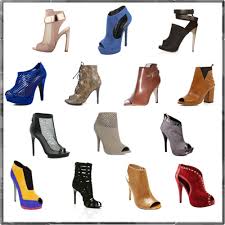|
Form doesn't necessarily follow function as far as fashion is concerned. Boots are the quintessential footwear for braving the elements, whether that be physical work or the weather they protect your feet. On the hand, heels and wedges are often worn in the workplace, and although they're not necessarily recognized for their comfort, they are revered for fashionably lengthening legs. Quite the opposite, flip flops are reputed for their extreme comfort, especially in sublime weather and work conditions. Now if you put all three of these together and what do you get? Open-Toe Boots. Huh?
Similar to a boot, with the heel of a stiletto, and with the peep-toe of a sandal. It is difficult to determine where to wear these shoes. For instance boots are worn during rain and snow, but this boot's open toe is impractical allowing your feet and toes to get wet, therefore basically defeating the entire purpose of shoes. Like flip flops, you may idealize wearing these shoes in a tropical climate, but since 90% of the shoe is boot and wearing socks is not recommended, your feet are going to sweat like crazy. This will most likely lead to stinky feet, blisters, and athletes foot. Try wearing these along the beach and you'll most certainly end up with sand cankle. Your last resort may be wearing these in the workplace, but if you do physical labor they don't make any sense and if you work a desk job they really don't make sense. So until shirts with extra sleeves and topless top hats become fashionable, save yourself the fashion faux pas and stick with one type of shoe.
0 Comments
Leave a Reply. |
LAJ
100 Objects of Popular and Material Culture is an blog exploring the manifestations of human consumption and commodity-ization. The purpose of this experiment is to explore material and popular culture in contemporary society by using objects and concepts to prompt wider questions and reflections. So by emulating The British Museum's and Neil MacGregor's format of A History of the World in 100 Objects I plan to satirically analyze and reinterpreted 100 material culture objects over the course of 2014. Material Culture is the study of our culture's consumption of stuff; namely the manifestation of culture through material productions where people's perceptions of objects is socially and culturally dependent. With this, objects reflect conscious and unconscious beliefs on the the individuals who fabricated, purchased, or used them, and by extension the society where they live. So examining materiality, cultural truths and societal assumptions may be discovered. As anthropologist Arjun Appaduai states "in any society the individual is often caught between the cultural structure of commodity-ization and his own personal attempts to bring a value and order to the universe of things." Objects and commodities make up a much larger symbolic system consisting of want and need, socio-economic status, fashion, etc. Often times form follows function whether the commodity, market, and or consumer forever evolve around one-another. Philosopher Pierre Bourdieu's theories of capital flow full circle; where regardless if you are a minimalist or a hoarder the world is made up of things and everyone will leave their footprint on the earth. So by humorously analyzing marketed objects and concepts, hopefully this blog will provide further incite into ideas of over-consumption, a disposable society, consumerism vs. anti-consumers, planned obsolescence vs. sustainability, as well as the greater good of mankind and future generations. Archives
March 2015
Categories |



 RSS Feed
RSS Feed